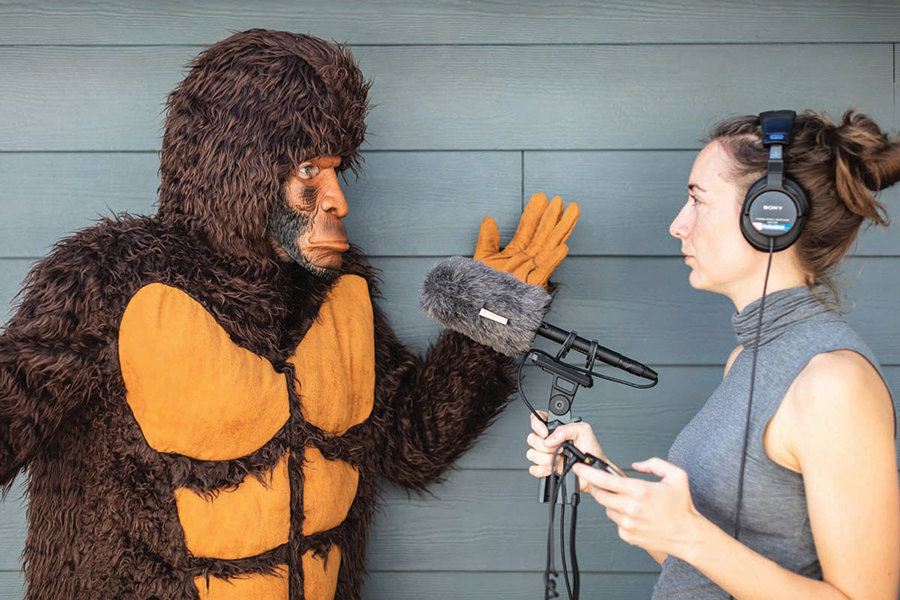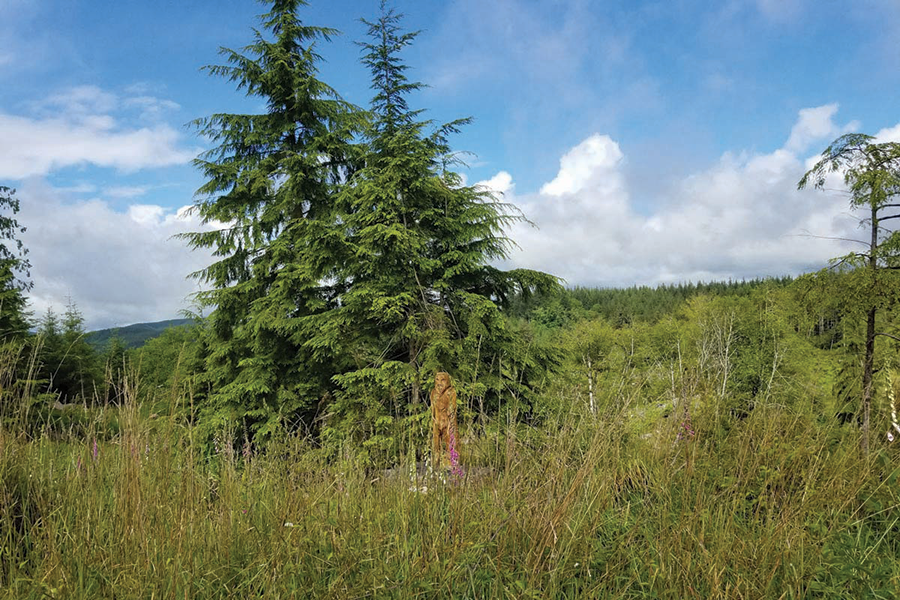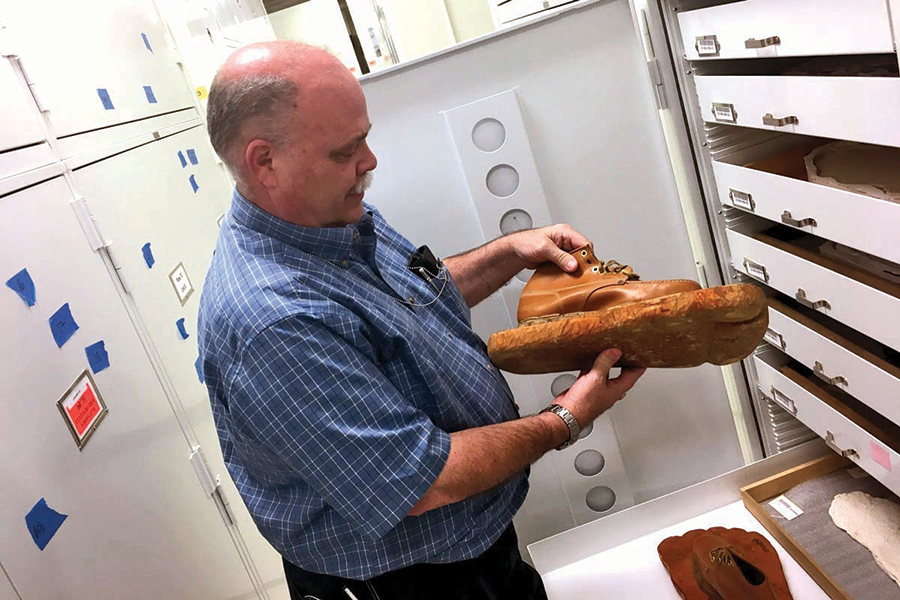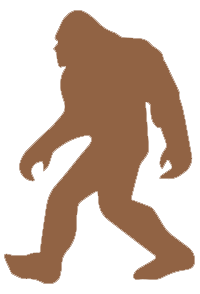Year
I brace myself as I open my email: Another note from someone who listened to my Bigfoot podcast, Wild Thing, and felt compelled to write me. Most of the time, it's a nice fan letter. Every so often, it's an outpouring of disappointment or an angry diatribe. And then there are letters like this one: "I know they exist—beyond a doubt, I have been physically touched on the shoulder by one on a mini-expedition in northeast Washington state—doing vortex photography and swapping stories with the sheriff's department of the local county. They are good folk, the Sasquatch people—they are so much more than a Wild Thing in the woods."
I'm relieved it's not hate mail—lambasting me for daring to question Bigfoot, or daring to explore Bigfoot, or just daring to have an opinion—but the letter leaves me cringing, embarrassed, asking why, exactly, I got myself into this. I spent the last two years researching and reporting a podcast on America's greatest myth, mainly in an effort to understand why a relative of mine, a well-respected professor of anthropology, became obsessed with Bigfoot, putting his reputation on the line in his search for the creature. Now I wonder if I've jeopardized my own reputation. I'm a serious journalist who has worked for NPR, covering subjects from foreign policy and politics to technology and literature. I've explored a wide variety of scientific topics. I believe in logic and rational thought, not spirits or magic. But then I went chasing Bigfoot. For two years. I talked with wildlife scientists, anthropologists and psychologists. I camped and hiked all over the Pacific Northwest. I attended Bigfoot symposiums and lectures and campouts. My eyes rolled (internally) at some people's stories, and my jaw dropped at others. And in the end, I could never completely eliminate the idea of Bigfoot from my mind.
I'm not crazy. And I'm not alone. From the dawn of human history, we've shared stories about creatures outside the bounds of civilization, avatars of the wild: Enkidu, Gilgamesh's wild companion in the Mesopotamian epic; Grendel, that greedy, loping shadow-stalker of the Danish fens; the Australian yowie; the Himalayan yeti. Bigfoot first appeared under its Salish name, Saskehavas, Sasquatch, in modern literature in 1929. Maclean's, the Canadian news magazine, described the Sasquatch as "strange people, of whom there are but few now—rarely seen and seldom met ... 'the hairy mountain men.'" Tribal nations of the Pacific Northwest used stories of Sasquatch to educate their children. How better to personify the unpredictable nature of the wilderness than with a mysterious, unpredictable wild thing? A creature like us—but not us. By the 1950s, (as U.S. tribes were being removed from reservations and relocated into urban areas) Sasquatch was fully appropriated as Bigfoot, becoming an American icon. Hundreds of books, countless TV shows ... and my own podcast. Why?
"I think we need [Bigfoot] in a deep-seated psychological way, because of our evolutionary origins," Robert Michael Pyle, a lepidopterist, naturalist and poet, told me in an interview late last summer. We were walking through a quiet and heavily forested glade in coastal Washington. "I think it goes all the way back to what we came from."
Half-wild creatures have been feeding the human imagination for thousands of years. We have evolved with them, and away from them. In the grand scheme of human evolution, we rarely lived without monsters at the edges. Gilgamesh's city-state, Beowulf's mead hall—these exist in opposition to Enkidu and Grendel. We fear the wild, and we miss it. For Bigfoot to exist, even in our imaginations, we need a landscape that can carry him. In a modern world that is so tamed, so pruned and paved, we are losing something that has long been with us and defined us. "Frankly, I think if we lose our connection to the wild," Pyle says, "we'll be far less human, less animal." Our belief in Bigfoot might be a sign of our spiritual health.
We live in an era of data and numbers, formulas, algorithms. We fantasize a future of super computers and robots, self-driving cars and delivery drones. Soon, we might never need to leave the house, let alone the city. But what's the cost of this severed connection with our animal selves? We'd do well to remember that we are not far removed from all life on Earth, even if we like to pretend we are. Bigfoot—that tether to a primitive state—is a reminder that the world is big and wide and wild.
In fact, cryptozoology (the study of animals whose existence is unproven) shares a common goal with its vaunted academic cousins: conservation. To search for Bigfoot is to identify and protect biodiversity and habitat. "The raison d'etre for any bigfoot research group is the ulterior motive—the important motive—which is conservation and preservation," John Kirk, one of many, many people I interviewed, told me on a rainy day, at a weekend-long Bigfoot symposium in Willow Creek, Calif. "That's what I'm doing it for. You have to prove they exist before you can save their habitat." Kirk, a policeman and the president of the British Columbia Scientific Cryptozoology Club, said he's firmly in the "Bigfoot exists" camp, but to him, that's beside the point.
"I think habitat's worth preserving plain and simple, but if you can put a biological rarity into that equation like they did with the spotted owl," he says. "Goodness gracious me—that's the only reason I would ever want to show the world [Bigfoot] existed."
On a cool, sunny weekend early last June, I took a trip to gated private timberland out on Washington's Olympic Peninsula. For months, I'd been hearing about some giant ground nests out there, discovered by the owner of the land, and now being observed and studied by a Bigfoot research group, the Olympic Project. A member guided me deep into the rhododendrons and spruce, well off the beaten path, and halfway down a steep ravine, so I could see the nests with my own eyes. I expected a pile of debris, something that resembled the mess left behind by spring runoff or a pounding storm. So I was wholly surprised by the 10-foot-diameter ground nests, woven as intricately as a bird's nest, and deep enough to hold a full-grown human. And there were many of them—21 in this area, though I only saw a handful. They looked nothing like a bear bed, and much more like the pictures I'd seen of the type of nests that gorillas make. And for the first time, I found myself more convinced of the possibility of Bigfoot than I'd ever been. The idea energized me; it felt electrifying and full of potential. What if, for all these centuries, people had been seeing this creature out in the forest? What if it really did exist, right under our noses? What would this mean?
Some of the world's great conservationists have been interested in cryptozoology, including the founder of the World Wildlife Fund, Peter Scott, who fought for classification of the Loch Ness monster. Bigfoot enthusiasts are, at heart, naturalists. They love being out in the woods, they love the environment, they love nature and everything that goes along with it. One guy I talked to refers to the search, sometimes called "bigfooting," as "hiking with a purpose," part of a general enthusiasm for the outdoors. Like fishermen and hunters (many Bigfooters are both), they are keen to protect wilderness—a place where the unexplained still happens.
In October 2017, at a Bigfoot conference celebrating the 50th anniversary of the Patterson-Gimlin film (the famous minute-long clip allegedly showing a Bigfoot walking away through the woods), I met John Mionczynski, a longtime wildlife biologist who had worked both federal and state agencies. Decades ago, as he was doing a wildlife survey in the Wind River Mountains of Wyoming, he had a hair-raising encounter. One night, he awoke to the sound of heavy breathing and the shadow of what resembled a bear on the wall of his tent. The creature poked its nose into the side of his tent; Mionczynski tried to scare it off by yelping and hitting it. It ran off, but came back a second time, and then a third. This time, the creature's silhouette was over the top of the tent and it looked like it was walking on two legs. Mionczynski thought the bear had grabbed onto the branch of the lodgepole pine that stuck out over his tent. So he hit it again. And this time he hit something hard as a rock. "And as soon as I did," he says, "this shadow came over the top of the tent, and it was a silhouette of a hand that was about twice the width of mine with an opposed thumb and hair between the fingers. Bears don't have that kind of a paw. And it was bigger than a bear's paw and it didn't have claws, it had fingers, with an opposed thumb."
Mionczynski lived to tell the tale, but the encounter has puzzled him ever since; despite all his professional and scientific training, it eluded any explanation he could come up with. Over two years, I spoke with dozens of people like him, like me—rational, logical people who subscribe to the laws of physics and biology, who have experienced something beyond their understanding, and just have to figure it out. They keep going out into the woods, hoping to catch another glimpse, to make more astute observations, to get a better sense of what is and what isn't. They are keen observers of the natural world. They run workshops to train Bigfoot newbies on how to recognize animal sounds and scat, to collect wildlife DNA and make casts of tracks. Bigfoot makes outdoor enthusiasts of people who might never have taken an interest. If the natural world needs anything right now, it's more people taking an interest. Does it matter how they get there?
As all wild things should, Bigfoot represents possibility and imagination—the tools of human progress. In the 1960s, Peter Higgs published a paper about an invisible substance that permeates all of space and has a particular effect on physics particles. The idea seemed so bizarre, so outlandish, that it was initially rejected. And yet, 50 years later, Higgs' ideas on quantum physics resulted in the discovery of the Higgs-Boson particle. Imagination, not logic, did that.
Even the pursuit of crazy ideas like Bigfoot can yield interesting discoveries. Back in 2012, an Oxford professor by the name of Bryan Sykes was perfecting a technique for getting DNA from hair. He began to wonder whether all the reported sightings of strange, hominid creatures around the globe might be evidence of a small, surviving populations of ancient human relatives, such as Neanderthals or Denisovans.
So Sykes asked people to send him hair samples from possible Bigfoot, yeti and other cryptozoological creatures. From nearly 100 samples, he extracted DNA from about 30. Most of the tufts turned out to be normal—bears, canines, raccoons, cows, sheep, people. But two samples made him take notice: They partially matched DNA found in the jawbone of an ancient polar bear, a species from 40,000 years ago. Sykes thought that this might have been the DNA of an unknown species of bear. He was wrong, but the excitement over that idea helped fund subsequent work by Charlotte Lindqvist, a bear geneticist at SUNY Buffalo. She learned that what were thought to be two subspecies of bear in the Himalaya were genetically distinct, and that one of them descended from a very ancient line of bears. Real or not, Bigfoot helped us achieve a better understanding of a critically endangered species we didn't know much about.
For Bigfooters, DNA is the next great hope. Many see it as the key to finding the physical Bigfoot evidence that's been sorely lacking. The tools available to scientists have become so powerful that they can sequence DNA with just a few skin cells—perhaps the very thing you might find in a giant ground nest out on the Olympic Peninsula. As I stood, mouth agape, staring at those nests last summer, the Olympic Project had already sent samples out to New York University, where a molecular primatologist would analyze them to see if they contained any unusual or unknown DNA. Every week, like clockwork, I'd email the guy, to see if he had results and I'd be lying if I said I wasn't hoping he'd find the genetic material of some unidentified primate. I started spinning out ideas of what this discovery would mean for science, for humanity, for the world. I understood how people became obsessed with Bigfoot because it seemed I'd caught a little bit of that bug, too. And then the analysis came back, with evidence of bats, shrews, humans, bears, deer, coyotes—but no Bigfoot. Nothing to indicate any primate other than human, and any creature other than what was typical for the area. Disappointing, to say the least. So when the primatologist told me that the nest samples were pretty degraded, that they weren't ideal, I began hoping that newer nests would be found and, with them, evidence of Bigfoot.
Yet all is not lost. For me, Bigfoot provided a better understanding of human evolution, DNA analysis, the psychology of belief and the basics of field biology—topics I might not have explored otherwise. Yes, finding a giant, undocumented primate in the North American woods would be unbelievably, gobsmackingly exciting (and likely provide a bit—just a tiny bit—of vindication for all the Bigfoot people out there). On the face of the current evidence, however, I do not think that Bigfoot exists. But that's not the point.
Even Bigfoot people have their doubts. And yet, the fascination persists. Why? Because even if he isn't real, we really, really need him. I spent the last two years chasing a shadow, suspending disbelief to imagine a world wild enough to hold something as extraordinary as Bigfoot. I didn't expect to find the idea of Bigfoot so integral to what it means to be human. But that electric, alive feeling I get when I look at the black wall of wilderness beyond the campfire light—that's Bigfoot. To look at the stars and wonder what's out there; to gaze into the ocean and imagine its depths; to imagine a better future for our planet, and come up with solutions—that's Bigfoot, too. If we can't imagine something like Bigfoot, if we can only envision the obvious answers, the next data point, we risk being mired in our own limitations. And one other thing: No one has proven that Bigfoot doesn't exist. So keep your eyes open, just in case.
A version of this article originally appeared in High Country News.
Bigfoot and the Beehive
A timeline of sasquatch sightings in Utah.
By Kelan Lyons
Although the majority of alleged Bigfoot sightings are in California, Oregon and Washington, Utahns are no strangers to glimpsing the mythical beast. You cannot, after all, spell "Sasquatch" without "Utah." According to the Bigfoot Field Researchers Organization (BFRO), there have been 69 such sightings in the Beehive State dating back at least as far as the 1960s. Apparently, the hairy monster can't resist our mountains. Or he's a Mormon. Here are a few notable examples from the past few decades:
Summer 1964: A pair of teenage campers taking a nighttime stroll in Cottonwood Canyon hear a "low guttural growl" they don't think comes from a person or cougar. Whatever it is ends up hiding in their cabin's outhouse before throwing open the door and running through the undergrowth. The next day, the boys find red-brown hair in a nearby wooded area.
July 1977: Two couples from Davis County reportedly see three hairy Bigfoots walking and running on two legs, romping about in a meadow. "They could not have been bears or other animals," Sgt. Fred Rosenberg tells the Davis County Clipper. "We don't know what they were but they were something that we have never seen before." A Harry and the Hendersons family vacation, mayhaps?
August 1977: Big game hunter Jay Barker tells Ogden's Standard-Examiner he and his companions saw a "gorilla-like" 10-foot-tall creature that walked on back legs, leaving "paw-like" imprints. A state conservation officer says it sounds like a grizzly bear, but when he gets to where Barker saw the brute, he finds a rabbit carcass that had been "skinned as by a human."
February 1980: A Clearfield man sees a 600-pound behemoth run across a highway near the Weber River. Earlier that month, others reported spotting something similar around the same area. Apparently, that space is a hotbed for Sasquatch activity. The BFRO has listed 10 sightings in Weber, the most of any county in the state. Maybe Sasquatch are the only Utahns drawn to the Great Salt Lake's stench.
July 1994: Boy Scouts in Summit County see a muscular, tall figure cloaked in darkness under some trees on the trail toward Baker Lake. In the most Utah-centric Bigfoot sighting in history, the person who filed the report said they suspected the creature was a Bigfoot, not a man, because it didn't say hi to the scouts.
August 2001: A couple fishing near Beaver, Utah, spots something that's covered in dark brown hair. Initially thinking the creature was a bear, the couple are in awe when the critter walks into the woods, indifferent to the spectators' presence. Their dog, just as confused as its human companions, doesn't even bark. Here's hoping the pup just thought it was fellow doggo Clifford.
October 2012: In one of the more famous Bigfoot sightings thanks to conspiracy theorists' pivoting to video, a camper spies a large, hairy figure squatting in the Provo Canyon woods. As the filmer whispers softly to his fellow hiker, the creature stands, striking a decidedly human-like pose. Scared, the humans make a mad dash to their car, leaving their tents behind.
December 2012: Two months after the Sasquatch squatter video, another Provo Canyon hiker spots a bipedal Bigfoot walking on a hillside. Taking a break from its menacing scowl, the beast crouches down before throwing something at the filmer. According to a YouTube video, this is the first time an alleged Sasquatch has been filmed throwing something. If it's a pioneer Bigfoot, it's come to the right place.
January 2019: Once again, people see a furry beast in Utah County, this time on the foothills northeast of Provo. "Was it a bear? Maybe. That's plausible. Was it a person? Also plausible," one witness tells Fox 13. "Was it something else? I think that's also possible. Who knows?" In other words, it could be anything. A shark? Jesus' return? The Utah Jazz mascot?
March 2019: Using a portable telescope, a few Utahns watch a big, dark figure trot up one of the Wasatch Range's mountains during a snowstorm. Considering the elevation is almost 9,000 feet, the creature is either a very in-shape human, a massive animal or yet another Sasquatch that calls the Provo area home. Perhaps this Bigfoot clan has a kid at BYU.







